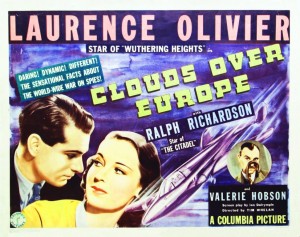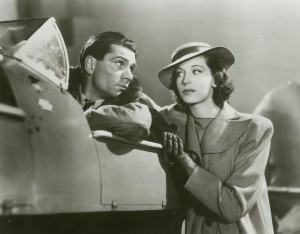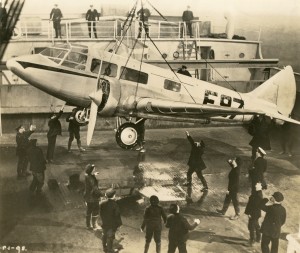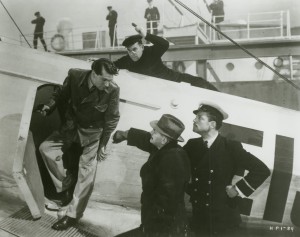 Our thirteenth potential classic is an odd but endearing espionage-comedy-drama from Britain on the eve of World War II originally titled Q Planes (1939). It was distributed in North America by Columbia Pictures, which didn’t like that moniker and changed it to Clouds Over Europe, by which it is best known today.
Our thirteenth potential classic is an odd but endearing espionage-comedy-drama from Britain on the eve of World War II originally titled Q Planes (1939). It was distributed in North America by Columbia Pictures, which didn’t like that moniker and changed it to Clouds Over Europe, by which it is best known today.
I first saw this movie in the early 1990s when working at QED Laser in Westmont, Illinois. It had been released on laserdisc and someone in the store recommended it to me. I was instantly captivated by its charm and humor, which is mainly supplied by Ralph Richardson and Valerie Hobson. I’ve been championing this film ever since — it (and It’s a Wonderful World) inspired my big article listing ten unsung movies of 1939 in Filmbobbery‘s Volume 5, Issue 4 in Spring, 2004. I still have the laserdisc!
Its story concerns a British airplane manufacturing company which has recently seen one of its experimental planes disappear on a test flight. A second flight is scheduled and the test pilots are jumpy because of the mystery. The head of the company, Mr. Barrett (George Merritt), is warned by Major Charles Hammand of Scotland Yard (Ralph Richardson) that another flight might suffer the same fate, but Barrett refuses to listen and orders it up anyway. Sure enough, it, too, disappears in mid-flight over the Atlantic.
No one has an inkling that a nefarious purpose is behind the disappearance, except for Major Hammond. He knows that other experimental planes from other countries have also disappeared, but even his own superiors discount his theory that one spy ring is behind it all. He goes it alone, aided and interfered with by a wily newspaper reporter, who just happens to be his sister. Kay Lawrence (Valerie Hobson) gets a job at the airport cafe and takes copious notes regarding the goings-on, but the men never notice because they’re all too busy flirting with her.

Kay tries to get information from pilot Tony McVane (Laurence Olivier) but she stupidly blows her cover on the telephone. Once he realizes she only wants the inside scoop for her newspaper, he gives her the air and frets incessantly about the missing crews. But when he meets Major Hammond and finds Kay at the major’s flat as well, his feelings begin to turn in a different direction. Thankfully the romance isn’t mushy at all; these two characters at odds with one another banter with witty repartee and insults before they finally begin to realize what they mean to each other. Perhaps my favorite aspect of this delightful movie is its perky dialogue, delivered with punch by a talented cast thoroughly enjoying themselves. I’ve read that American director Tim Whelan encouraged his stars to improvise certain scenes and was very happy with the result. The movie is chippy and clever, and moves along at a fairly rapid pace, which means that it shouldn’t bore modern audiences as some old films do.
The comedy starts at the beginning, when police enter the offices of the “Eastern Importation Company” and find a man sleeping — who is supposed by one of the constables to be dead. It is Major Hammond, who pretends that he does not know who he is because he knows that is the fastest way to be taken back to headquarters without having to answer a lot of questions. Major Hammond is rather eccentric, seemingly scatterbrained, and always ready to dash off at a moment’s notice. A running gag involves a woman he is seeing, and whom he must call at inopportune moments, putting off their planned dates because he is busy with the missing airplane investigation. His comeuppance arrives at the film’s coda, when he finally does arrive on time for a tryst.
In fact, the film’s comic aspects outweigh just about every other element. Although the story is nicely plotted, and contains more than enough suspense and mystery elements to qualify as either of those, it is the amusing characters and their clever byplay which make the story so memorable. Even the most dramatic scenes are as lighthearted as possible, from the planes having to ditch without power in the ocean while their pilots make light of their predicaments, to the capture of the crews by the spy ring and the crews’ bemused reactions.
When Columbia retitled the film Clouds Over Europe, it did so because the story seemed to predict political unrest and the ever-growing risk of espionage and sabotage by enemy agents. That is true enough, yet the film fails to detail exactly who the spies actually are. The vessel they use is the salvage ship S. S. Viking; the crew seems to be German, but it is never explicitly identified as such, and various other nationalities and accents seem to be present on board. Viewers can assume that the spies are German, a reasonable assumption, but it is an assumption. I think the filmmakers wished to be as timely as possible regarding the political situation, yet they also wanted to be cautious enough not to point fingers. If the movie had been made a year or two later such ambiguity would certainly not be present. And the tone of the piece would have been much, much darker.

Another of the hallmarks of a good movie is that supporting characters are sharply defined and have their own moments of glory. Hammond’s put-upon butler / valet Blenkinsop (Gus McNaughton), for instance, is constantly harangued by his boss, yet accompanies Hammond on his crucial trip to Cornwall when one of the missing planes is found there. Barrett’s confidential secretary, Jenkins (George Curzon), is integral to the plot and is quite convincing when his luck takes a turn for the worse. And even Daphne (Sandra Storme), Hammond’s inamorata, makes a strong impression in her all-too-brief segments. All these people and more are caught up in the whirlwind that surrounds Major Hammond as he rushes around from place to place attempting to determine who is responsible for the disappearance of the test planes.
Ralph Richardson is an absolute hoot as Major Hammond, whether trying to convince Barrett of the danger or cooking what looks to be an abominable stew after his case has been discredited and closed. Hammond’s banter with Blenkinsop is just right and his relationship with his career-minded sister is memorable. Valerie Hobson’s Kay is a real feminist, ahead of her time when she insists that her right to cover the story is just as valuable as her brother’s investigation — and that she is the one doing the better job! Hobson’s performance is quite good, especially early in the film when she is tossing off one-liners with the boys and, later, in the airfield sequence when she is trying to stop the test flight with McVane.
This movie was released the same year as Wuthering Heights, which may explain just why it has been overlooked for so long. Laurence Olivier is quite dashing as test pilot Tony McVane, whether insulting Barrett for not acknowledging the spy menace earlier or manning the machine gun on the Viking when the captive crews revolt. But his best moment arrives after Hammond has left him alone with Kay and the stew, and Kay testily asks him to leave. McVane places the towel and the apron on Kay, hands her the spoon and then very tenderly says, “Goodbye, darling,” two words which forever change the way she thinks and feels about him.
It is evident that the budget was small for this adventure; some of the same shots are used in both segments in which the test planes are disabled by the enemy ray. Stock shots show planes flying, guns firing, and the Naval destroyer sent after the Viking. Models are used for the salvage scenes, while the plane interiors in the two flight sequences are almost laughable. Still, the film does a lot with a little, and the overall effect is a positive one, even when the technical dialogue doesn’t always match or is irritatingly redundant.

It seems hard to believe that Britain could have produced such a light-hearted spy adventure at the time, given the political climate, but few realized or believed that England would suffer as she soon did. The filmmakers produced a film with popular appeal, laced with witty, fast-paced dialogue, emphasizing fun over its other elements. This certainly qualifies as a propaganda piece, given how the British pilots and crews revolt against their unidentified foreign captors and how one lone Scotland Yard investigator (and a bumbling one at that) solves a mystery that has baffled the world. Some, perhaps much, of its propaganda level has been provided in hindsight, as we look back at the era and identify themes and elements which place the film squarely as pre-war patriotism. I think that director Tim Whelan and his crew were more interested at the time in creating an unusual, enjoyable espionage adventure that might be a bit more prescient than one would expect from such a project.
Is Q Planes a classic? Heck, yes! Just because it has never become widely known should not diminish the film’s solid quality and delightful appeal. It is memorably funny, with excellent performances from its trio of stars as well as those persons supporting them. It works as a mystery and (less so) a suspense film, succeeding more as a comedy than anything else. Despite its serious subject matter it manages to generate a lot of fun, leavening its wisdom about relationships, careers, espionage and sibling rivalry with quips and tart comebacks meant to enhance its flavor. This is one of my favorite films from 1939, the world’s greatest year in cinema, and it is definitely worth a look. ☆ ☆ ☆ 1/2. 16 August 2014.
